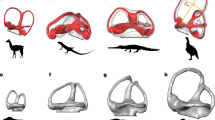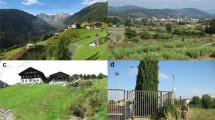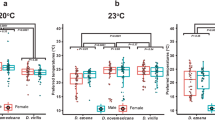Abstract
IN an investigation on physiological and ecological problems in Forficula auricularia, van Heerdt1 found that well-fed, non-desiccated earwigs showed no humidity preference in the alternative chamber ; but if previously desiccated, the earwigs became distinctly hygropositive. Whenever Forficula is found in dry places, its presence there is, according to van Heerdt, to be ascribed to thigmotaxis. Experiments begun in the winter of 1946–47 gave results closely resembling those of van Heerdt. In the summer of 1949, however, when the experiments were continued, the earwigs (both specimens taken directly from very dry natural conditions, and specimens kept in moist air even for weeks) showed a clear and strong preference for the drier side of the alternative chamber. Two-hour experiments were carried out in the day-time, but in darkness with the exception of short intervals for counting. With a choice between 100–34, 100–97, 100–99.5, 97–87, 77–34, 34–20 and 34–0 per cent relative humidity, the drier humidity was consistently preferred by the summer earwigs. Desiccation, however, caused even the summer earwigs to choose the moist air. These same specimens, well-fed and kept in a moist atmosphere all the time, so that the effect of desiccation was excluded, were investigated in the following winter. It appeared that the animals no longer showed the dry reaction, but tended now to prefer 100 to 34 per cent relative humidity. The experiments were repeated in the summer of 1950 and winter of 1950–51, with results similar to those obtained in the earlier years.
This is a preview of subscription content, access via your institution
Access options
Subscribe to this journal
Receive 51 print issues and online access
$199.00 per year
only $3.90 per issue
Buy this article
- Purchase on Springer Link
- Instant access to full article PDF
Prices may be subject to local taxes which are calculated during checkout
Similar content being viewed by others
References
van Heerdt, P. F., “Eenige physiologische en oecologische Problemen bij Forficula auricularia”, thesis, Utrecht (1946).
Beier, M., “Dermaptera”, Orthopteren I, in Schulze's “Biologie der Tiere Deutschlands” (Berlin, 1933).
Author information
Authors and Affiliations
Rights and permissions
About this article
Cite this article
PERTTUNEN, V. Seasonal Change in the Humidity Reaction of the Common Earwig, Forficula auricularia. Nature 170, 209–210 (1952). https://doi.org/10.1038/170209b0
Issue Date:
DOI: https://doi.org/10.1038/170209b0
This article is cited by
-
Étude expérimentale de l'hygrotaxie chez le Termite de Saintonge (Reticulitermes lucifugus Santonensis)
Insectes Sociaux (1973)
-
Seasonal changes in the daily rhythms of animals
International Journal of Biometeorology (1966)
-
Die Abh�ngigkeit der Luftfeuchte-Reaktionen der Mehlmilbe (Acarus siro L.) vom Wassergehalt des K�rpers
Zeitschrift f�r Vergleichende Physiologie (1962)
Comments
By submitting a comment you agree to abide by our Terms and Community Guidelines. If you find something abusive or that does not comply with our terms or guidelines please flag it as inappropriate.



